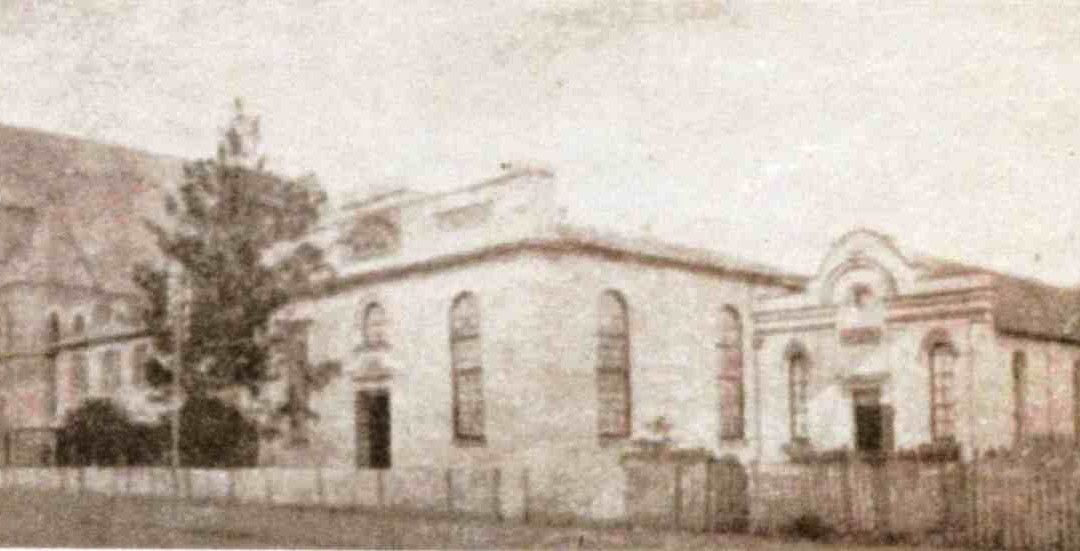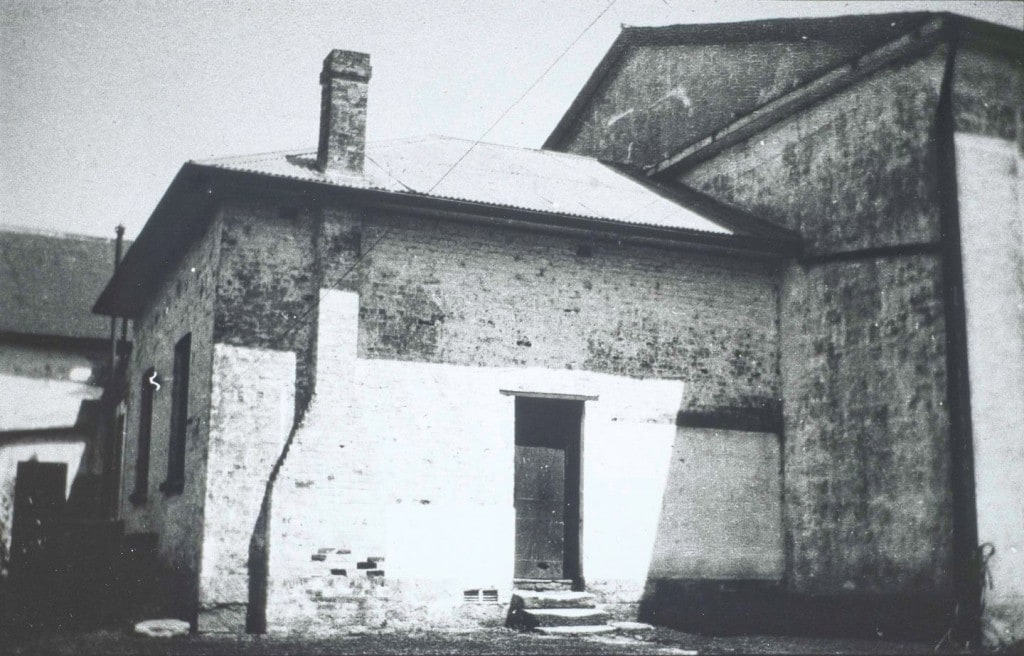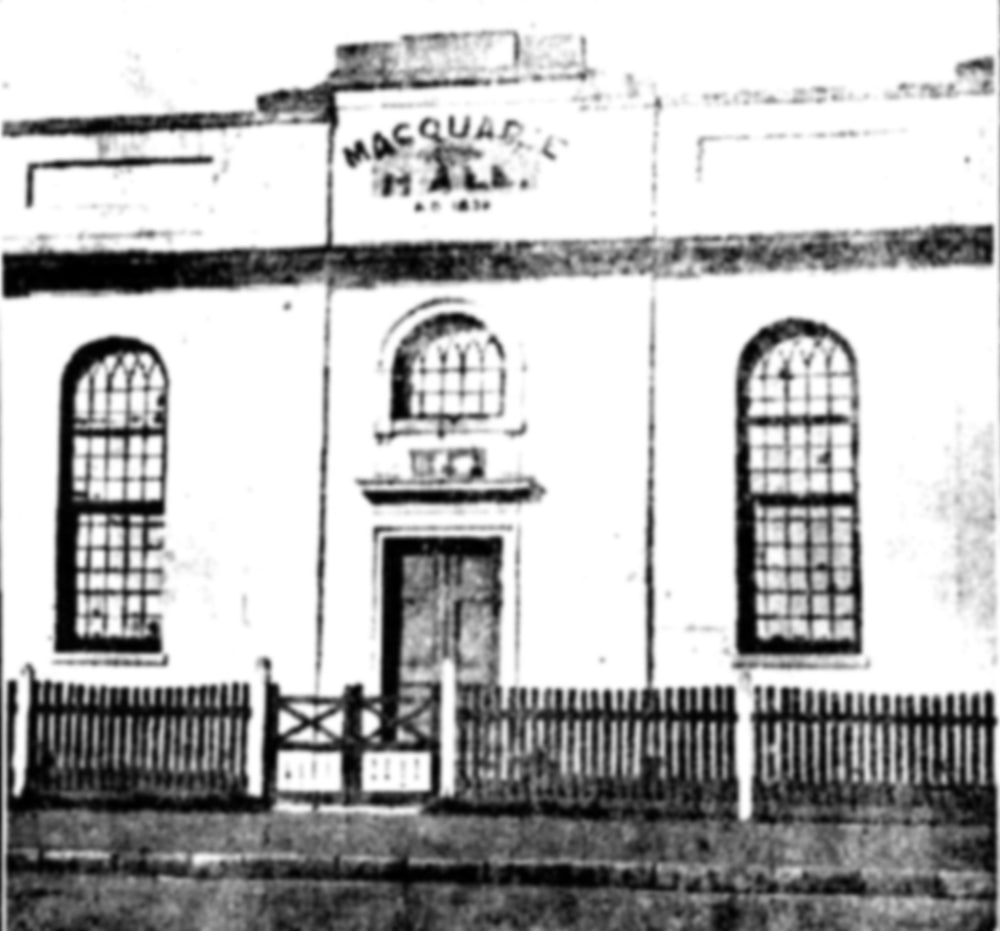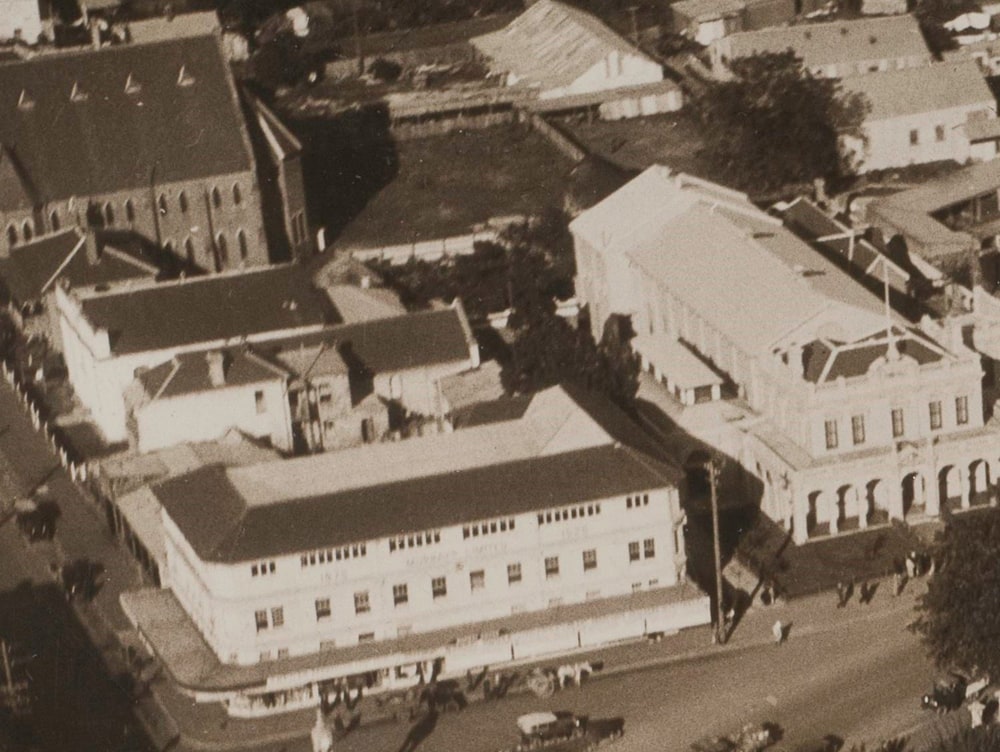
Erected in 1838, the ‘Macquarie Hall’ building stood for many years near Leigh Memorial Church on Macquarie Street. For thirty-five years it was the principal place of worship for the Methodist Church in Parramatta and in this period it was not called a church but was referred to as the Wesleyan Chapel.[1]
The two towering figures in the early Methodist movement in Australia were Samuel Leigh and Walter Lawry, they arrived in the Parramatta in 1815 and 1818 respectively. With no place of worship in the colony Lawry at first preached from private homes.[2] But on 20 January, 1821, he laid the foundation stone of a small chapel on land behind the Parramatta Markets and near where Macquarie Hall would later stand. It was opened for worship in April of the same year but the increasing number of worshippers made building a new church a pressing necessity and by 1939 only a small portion of this original chapel would still remain.

Old Lawry Chapel building, rear of Macquarie Hall, Macquarie Street, Parramatta City Council, Heritage Centre, LSP00185
In the 15 or so years since it opened the growing congregation put pressure on the little building and a new minister, Rev. D. J. Draper, set about initiating a project to build a larger chapel in Macquarie Street. In 1836 he outlined how;
… we have determined to erect a good new chapel 60 feet by 40 feet. We shall then be able to convert the old one into a vestry and school room, which are very much needed.[4]
The foundation stone was laid in 1838 and the chapel was opened in September 1839, the whole having cost some 1450 pounds-sterling. The building saw a great deal of use with many of Parramatta’s best known citizens attending sermons there and its links with the Wesleyan Missionaries ensured it had strong ties to the Pacific Islands as well. On one occasion in the late 1800s, King George of Tonga, spoke from the pulpit, on another Rev. S. Rabone interpreted for two famous Tongan ministers David a Kata and Barnabas Ahongalu.
In 1841 a single story parsonage, ‘Leigh House’, was erected next to Macquarie Hall and in 1860, James Houison supervised the conversion of this building into a more substantial two-storey house.[12] In 1950 the church bought a house on the corner of Marion and Harris Streets, Parramatta, to be used as a new parsonage and by 1951 Leigh House was being used as offices. It was demolished in August, 1957.
But Macquarie Hall opened it s doors in 1839 and continued to be the primary place of worship until the middle of the 18880s. In 1869 under even more pressure from the growing population a further thirty feet were added to the length of the building and a wing on each side with sliding doors constructed to improve access for the parishioners.
Finally when the when the new Leigh Memorial Church was opened in 1885, this building ceased to be the main place of worship and from this time on was referred to as Macquarie Hall”.[5]
A fourth Methodist building occupying this Macquarie Street frontage was built next door to Macquarie Hall. This opened in 1865 and was called “Jubilee Hall”, in commemoration the Jubilee of Australian Methodism which occurred in that year. In This building was added to provide additional accommodation for the Sunday School programs initiated by the Methodists.[6] It was sold to M/L.C. in 1953 and was subsequently converted into shops.
One of the more popular uses for the buildings was for the delivery of Sunday school services, among the first in Australia, to the children of Parramatta. On Thursday 12 October 1871 James Byrnes, an ex-mayor and committed Methodist opened a new ‘Sabbath Schoolroom’ on Macquarie Street. Some 200 people were there to witness Byrnes place a bottle under the foundation stone with a copy of the day’s Sydney Morning Herald and a document written by the church. A full description of this document can be found here on TROVE.
In 1925 Macquarie Hall and Jubilee Hall underwent some major repairs which for Macquarie Hall included:
… new fibrous ceiling, a new jarrah floor with brick piers and renewals throughout. The hall has been transformed in appearance and when the seating has been installed and the exterior finished will be a decided improvement to the town.[7]
In 1926 the repairs were complete and the building was reopened. During these ceremonies the speakers reiterated the importance of the hall and surrounding buildings to the story of Australian Methodism and the significance of Parramatta to the beginnings of Methodism in New South Wales:
“This Hall,” said Rev R. J. Murray when introducing the chairman, “carries the most sacred memories and hallowed associations.” In addition he said that the … premises at the back of the hall constituted the oldest remaining edifice of Australian Methodism. It would have been a sad calamity had these buildings been allowed to fall into decay.[8]
The Reverend Stephen went even further claiming Parramatta was the font of Australian Methodism and that the Hall and the adjacent buildings had seen sermons by some of their finest ministers including Samuel Leigh: Walter Lawry; A. J. Manton; and Daniel Draper.[9]
In 1933, at the height of the depression, the church sold some of the lands at the rear of the Leigh Memorial Church (LMC), and by the middle of the 1950s was thinking of redeveloping its properties in light of the Parramatta City C0uncil plans to build a new administration block at the rear of the church’s buildings. In 1957 the remains of the original chapel were demolished, along with the parsonage, and a year later they had negotiated a deal with City Council. This saw the exchange of land on the eastern side of the church for property owned the rear of the old parsonage and Macquarie Hall. In 1961 they purchased Dr. Johnson’s old house, next to the LMC, from Miss Dalton.
Three years later, in March 1964, the Leigh Fellowship Worship Centre was opened on this site by Sir Garfield Barwick.
![]() Geoff Barker, Research and Collection Services Coordinator, Parramatta City Council Heritage Centre, 2015
Geoff Barker, Research and Collection Services Coordinator, Parramatta City Council Heritage Centre, 2015
References
[1] Cumberland Argus and Fruitgrowers Advocate, 19 March, 1926, http://trove.nla.gov.au/ndp/del/article/104948336
[2] Cumberland Argus and Fruitgrowers Advocate, 26 October, 1938, http://trove.nla.gov.au/ndp/del/article/104974565
[3] Cumberland Argus and Fruitgrowers Advocate, 11 October, 1939, http://trove.nla.gov.au/ndp/del/article/106215865
[4] Cumberland Argus and Fruitgrowers Advocate, 19 March, 1926, http://trove.nla.gov.au/ndp/del/article/104948336
[5] Cumberland Argus and Fruitgrowers Advocate, 19 March, 1926, http://trove.nla.gov.au/ndp/del/article/104948336
[6] Cumberland Argus and Fruitgrowers Advocate, 26 October, 1933, http://trove.nla.gov.au/ndp/del/article/107800967
[7] Cumberland Argus and Fruitgrowers Advocate, 30 December, 1925, http://trove.nla.gov.au/ndp/del/article/10375814
[8] Cumberland Argus and Fruitgrowers Advocate, 6 April, 1926, http://trove.nla.gov.au/ndp/del/article/104960228
[9] Cumberland Argus and Fruitgrowers Advocate, 6 April, 1926, http://trove.nla.gov.au/ndp/del/article/104960228
[10] From Small Beginnings; Parramatta regional mission, Gloster S. Udy, 1988, Parramatta City Council, Ls.283.9441
[11] Parramatta Church History, Lights in the Southern Sky, J. E. Carruthers
[12] Spark of Grace, Gloster Udy, 1977




